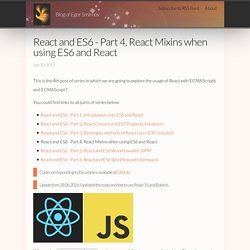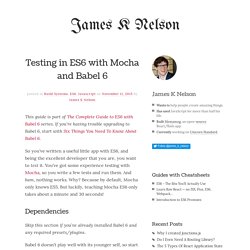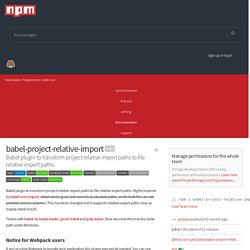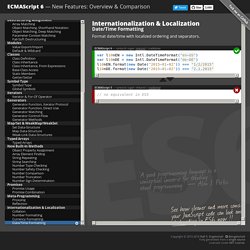

Learn ECMAScript6 by doing it. Learn ECMAScript6 by doing it. React and ES6 - Part 4, React Mixins when using ES6 and React. This is the 4th post of series in which we are going to explore the usage of React with ECMAScript6 and ECMAScript7.

You could find links to all parts of series below: Code corresponding to this article is available at GitHub. React and ES6 - Part 4, React Mixins when using ES6 and React. Testing in ES6 with Mocha and Babel 6. This guide is part of The Complete Guide to ES6 with Babel 6 series.

If you’re having trouble upgrading to Babel 6, start with Six Things You Need To Know About Babel 6. So you’ve written a useful little app with ES6, and being the excellent developer that you are, you want to test it. You’ve got some experience testing with Mocha, so you write a few tests and run them. And bam, nothing works. Why? Dependencies Skip this section if you’ve already installed Babel 6 and any required presets/plugins. Babel 6 doesn’t play well with its younger self, so start by removing any older Babel packages from package.json — babel, babel-core, etc. We’ll need to install the babel-core package to get access to its require hook: npm install babel-core --save-dev Once complete, you’ll need to install the presets and plugins you want to use to transform your code.
Babel-project-relative-import. Babel plugin to transform project relative import paths to file relative import paths.

Babel plugin to transform project relative import paths to file relative import paths. Highly inspired by babel-root-import. which works great, but converts to absolute paths, so the built files are not portable accross systems. (This has been changed and it supports relative output paths now, so maybe check it out!) Tested with babel-cli, babel-loader, grunt-babel and gulp-babel.
Does also transform to the same path under Windows. Notice for Webpack users If you're using Webpack to bundle your application this plugin may not be needed. Upgrade from 1.x There are two breaking changes: Renamed option projectPathSuffix to sourceDir to be less confusing.The option importPathPrefix automatically added a / to the supplied prefix in previous versions, this has been removed and allows for prefixes like ^dir/test. Example. ECMAScript 6: New Features: Overview and Comparison. "A good programming language is a conceptual universe for thinking about programming.

" — Alan J. Perlis Constants Support for constants (also known as "immutable variables"), i.e., variables which cannot be re-assigned new content. Notice: this only makes the variable itself immutable, not its assigned content (for instance, in case the content is an object, this means the object itself can still be altered). ECMAScript 6 — syntactic sugar: reduced | traditional const PI = 3.141593; PI > 3.0; ECMAScript 5 — syntactic sugar: reduced | traditional Scoping Block-Scoped Variables Block-scoped variables (and constants) without hoisting. for (let i = 0; i < a.length; i++) { let x = a[i]; …}for (let i = 0; i < b.length; i++) { let y = b[i]; …} let callbacks = [];for (let i = 0; i <= 2; i++) { callbacks[i] = function () { return i * 2; };} callbacks[0]() === 0; callbacks[1]() === 2; callbacks[2]() === 4;
Addyosmani/es6-tools: An aggregation of tooling for using ES6 today. Learn ES2015 · Babel. Es6features This document was originally taken from Luke Hoban's excellent es6features repo.

Go give it a star on GitHub! REPL Be sure to try these features out in the online REPL. Introduction ECMAScript 2015 is an ECMAScript standard that was ratified in June 2015. ES2015 is a significant update to the language, and the first major update to the language since ES5 was standardized in 2009. See the ES2015 standard for full specification of the ECMAScript 2015 language.
ECMAScript 2015 Features Arrows and Lexical This Arrows are a function shorthand using the => syntax. Classes ES2015 classes are a simple sugar over the prototype-based OO pattern. Class SkinnedMesh extends THREE.Mesh { constructor(geometry, materials) { super(geometry, materials); this.idMatrix = SkinnedMesh.defaultMatrix(); this.bones = []; this.boneMatrices = []; //... } update(camera) { //... super.update(); } static defaultMatrix() { return new THREE.Matrix4(); }} Enhanced Object Literals Template Strings Destructuring. Le standart ECMA6. React. Exploring ES6. ES6 cheatsheet. ECMAscript 6 Lessons - Screencast Video Tutorials. Introduction à ECMAScript 6 : Le JavaScript de demain. Les technologies web ne cessent d’évoluer, aujourd’hui nous allons parler d’ES6, la nouvelle version du langage JavaScript.

Elle apporte un lot conséquent de nouveautés, de l’ajout de nouvelles fonctions à la bibliothèque standard, à plusieurs nouvelles syntaxes, dont les classes, les modules et bien plus encore. Historiquement, le langage JavaScript a longtemps été mis au deuxième plan dans la conception des pages web, servant principalement à réaliser des animations diverses. Aujourd’hui les choses sont totalement différentes, on parle désormais d’application web, entièrement contrôlées via du code JavaScript.
Malheureusement, le langage n’a pas été conçu pour créer des applications complexes, il en résulte ainsi des syntaxes très lourdes.Cela va changer très prochainement avec l’arrivée d’une nouvelle version du langage : ECMAScript 6, alias JavaScript 2015 ! ES6 a été pensé pour créer des applications web facilement maintenables, tout en restant compatibles avec le code existant. Addyosmani/es6-tools.